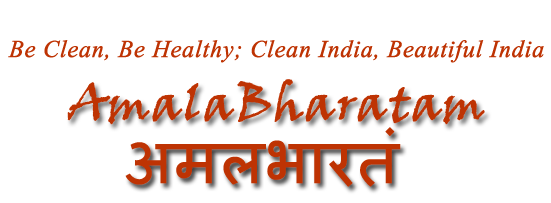400 truck loads of waste collected by 4000 volunteers
The ‘Amala Bharatam’ Campaign was started by the students of Amrita Viswa Vidya Peetham, Amritapuri Campus on August 15th, 2010. Amma gave them inspiration and guided them what to do and supported them to carry on. Later Ashramites and devotees joined this when Amma announced this project as Amala Bharatam – to clean India to make her healthy and beautiful – on her 57th birthday celebration on 27th Sep 2010.
Here are some statistics of the Amritapuri based ‘Amala Bharatam’ Campaign as on 31st Oct 2010
Places and distances covered
1. Vallikkavu to Vavvakkavu – 6 kms
2. Vavvakkavu to Puthiyakavu on NH47 – 5 kms
3. Puthiyakavu to Karunagappally on NH 47– 4 kms
4. Karunagappally Town on NH47 – 5 sq. kms
5. Sasthamcotta Lake – Drinking water resource for Kollam district – 4 square kms
6. Karunagappally Temple and Market – 3 sq. kms
7. Oachira Temple premises and Town – 4 sq. kms
8. Vavvakkavu to Haripad on NH47 – 22 kms
Towns covered – Vallikkavu, Vavvakkavu, Puthiyakavu, Karunagappally, Sasthamcotta, Oachira, Kayamkulam, Haripad – Total 8
Total road distance covered – 37 kms; On NH47
Total area covered in town cleanups – 20 sq.kms
No of students who participated in the Cleanup drive
1. Vallikkavu to Vavvakkavu – 300 volunteers
2. Vavvakkavu to Puthiyakavu on NH47 – 400 volunteers
3. Puthiyakavu to Karunagappally on NH 47– 400 volunteers
4. Karunagappally Town on NH47 – 500 volunteers
5. Sasthamcotta Lake – Drinking water resource for Kollam district – 400 volunteers
6. Karunagappally Temple and Market – 400 volunteers
7. Oachira Temple premises and Town – 500 volunteers
8. Vavvakkavu to Haripad on NH47 – 22 kms – 1200 volunteers
In all, 4,100 volunteers participated in the dawn to dusk (6.30 am to 7.00 pm) cleanup drive in all these locations.
Volunteers belong to students of Amrita Vishwa Vidyapeetham, Amritapuri Campus from School of Ayurveda, Engineering, Arts & Science, Biotechnology and Business. In addition students from Amrita Industrial Training Centre, brahmacharies and brahmacharinies of MA Math and devotees also participated in the drive.
Truckload of waste disposed / buried / recycle during each drive
1. Vallikkavu to Vavvakkavu – 20 truckload
2. Vavvakkavu to Puthiyakavu on NH47 – 25 truckload
3. Puthiyakavu to Karunagappally on NH 47– 25 truckload
4. Karunagappally Town on NH47 – 50 truckload
5. Sasthamcotta Lake – Drinking water resource for Kollam district – 40 truckload
6. Karunagappally Temple and Market – 40 truckload
7. Oachira Temple premises and Town – 50 truckload
8. Vavvakkavu to Haripad on NH47 – 120 truckload
Total waste disposed – 400 truck loads over 8 cleanup drive
Each truckload is around 8 – 10 tonnes of waste – both recyclable and non – recyclable
Around 10 – 15 percent of the waste is recyclable. Most of the waste is bio-degradable waste
Disposal of waste:
Biodegradable waste is buried in pits dug up by JCBS in suitable places identified in advance, both on the sides of roads and private property, depending on the availability.
Recyclable waste such as plastics, metals, paper, packaging material, etc. is transported to the recycling centre in Amritapuri.
Other Key Information
Vehicles used – JCBs, Tippers, Trucks, tractors, medium and small sized tempos and carriers
Tools used for the cleanup work – showels, spades, sickles, rakes, brooms, gloves, masks, etc.
The volunteers are organised into various teams. Broadly the teams constitute of
1. Waste gathering team
2. Waste disposal team
3. JCB / Tipper team
4. Tools team
5. Water and refreshment team
6. Awareness Campaign team
7. First Aid team
The kind of activities typically carried out during the cleanup drive is:
1. Deciding the location – extend and scope of work
2. Identifying the areas to be cleaned
3. Survey of the total volume and type of waste to be cleared
4. Identifying spots for burying biodegradable waste
5. Securing permission from concerned authorities for digging pits
6. Informing all concerned authorities – Municipality, panchayat, police, water authority, PWD, telephones, Electricity board, local establishments, etc
7. Forming volunteers into manageable groups under a team leader
8. Sourcing tools for the work to be carried out
9. Assigning tasks to each team
10. Arranging for various resources like vehicles, medical aid, refreshments, etc to support the clean up drive.
11. Train volunteers to carry out awareness campaign
12. Document the work such as photos, videos, etc. to create material for awareness campaign in communities for volunteer registrations.
